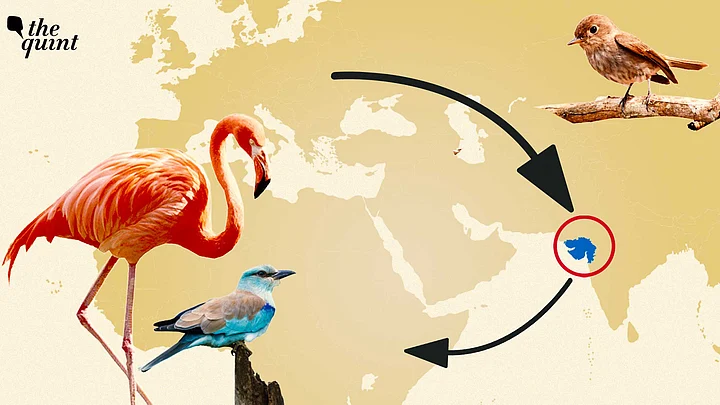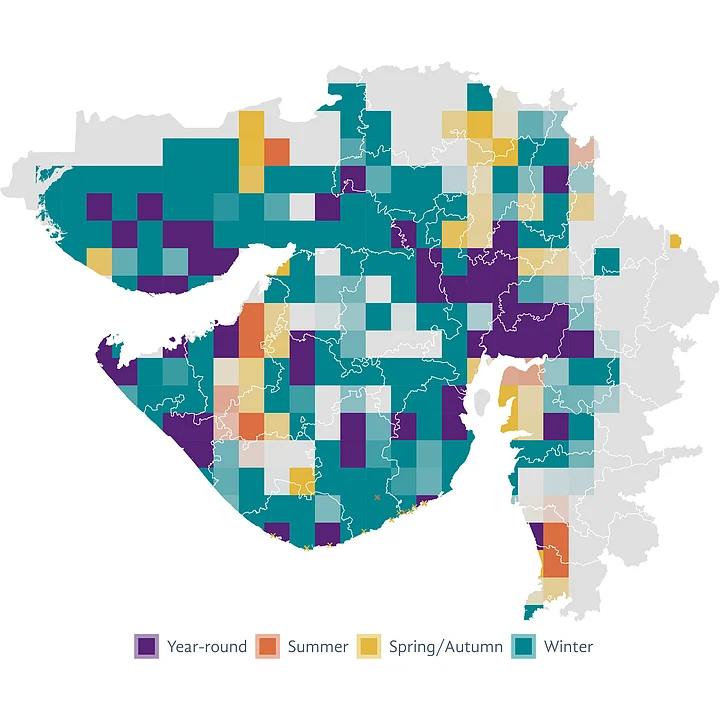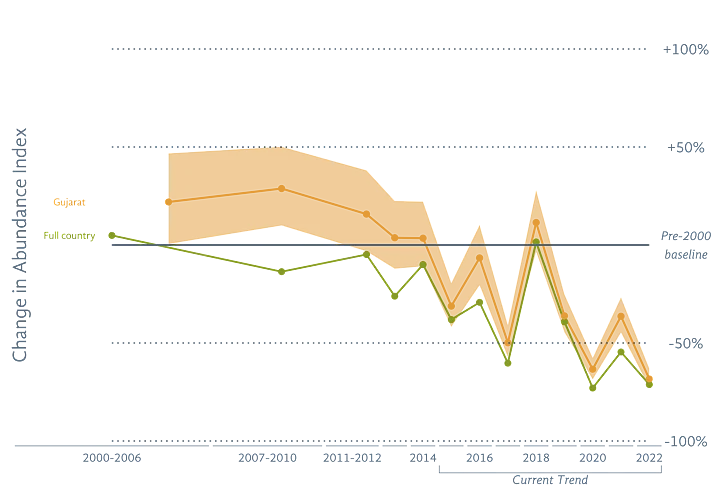Are we prepared for the climate crisis staring us in the face? The Quint wants to go big on telling the most important stories of our time. Support us to tell them. Become a member now.
Kutch, the vast desert land in Gujarat, is teaming with exotic species of birds from all over the world at this time of the year – from the more flamboyant flamingos and spoonbills to the more modest common cuckoo.
Many of these are just passing through.
Kutch – the most important place for passage migration in India – acts as a pitstop for migratory birds, travelling from their breeding grounds in Central Asia and Europe, to rest and recoup before they embark on their long journey across the Arabian Sea to Africa.
According to primary data from 13-15 September of the Passage Migrant Count (PMC) 2024 survey, only 738 individual passage migratory birds of eight different species were observed in Kutch district over the two days. PMC is a citizen science initiative organised by Bird Count India in collaboration with the Bird Conservation Society Gujarat.
In 2023, observers had spotted 1,221 birds of the same eight species – European Roller, Red-backed and Red-tailed Shrike, Spotted Flycatcher, Rufous-tailed Scrub-Robin, Greater Whitethroat, Common Cuckoo and Blue-cheeked Bee-eater – during the same period.
What does this mean? Why does the pattern of migrant birds matter?
The Passage Migrant Birds of Kutch
Speaking to The Quint, Mayuri Jain, one of the researchers who collected data for the PMC 2024 survey, explains that the passage migrant birds are generally in Kutch for 15-20 days between mid-August and mid-October before crossing the sea to Africa.
"We have been focused on eight species of passage migrant birds since 2021, and we have particularly noted a decline in these eight species over the last two years."Mayuri Jani
Before we get into why that is, and what it means, let's go over why this region is such a hotspot for migratory birds – winter, summer and passage migrants alike.
According to Jani, one reason for this could be the abundance of food for these birds in this region during this time of the year.
"In arid regions like Kutch, there is much insect population after the rainy season. Some of the locust populations also migrate through this region which is a great source of food for insectivorous birds."Mayuri Jani, Bird Observor and Environmentalist
Another researcher associated with the Nature Conservation Foundation, Ashwin Vishwanathan, adds,
"This region is also quite critical for a huge population of Asian and European winter migratory birds. Largely because of the vast expanse of water bodies. There is a lot of water and food available, and also multiple kinds of habitats like forests, wetlands, grasslands that makes it conducive for a large variety of birds."
As many as 135 volunteers from 18 states participated in the data collection exercise. Each one of them was allotted teams in different zones spread across Kutch district.
While the final report is yet to be officially published, Jani tells the Quint that one of the reasons for the decline in passage migrant birds this year specifically could be the delayed monsoons. "The birds are very sensitive to weather patterns in all the regions that they travel through," she explains.
But she also adds that this is not necessarily a cause for concern yet.
"We stayed in Kutch for a few more days after our survey was completed, and actually we could observe that the density of birds increased then," she says, adding, "This could just mean that they were delayed by a few days because of rains."
Jani and her team have only been collecting this data annually since 2021. She says, "Only when we have data for a few more years can we compare it to the previous years to assess the quantitative change in numbers."
Apart from passage migratory birds, other birds that frequent the area like flamingos, McQueen’s bustard, and the common crane have also seen a decline in the past decade, according to the State of India's Birds report of 2023.
For instance, according to the report, the greater flamingo – one of the most common species of flamingo in the world – has been classified as a species of 'high conservation priority' in India.
- 01/02
The area in Gujarat where the greater flamingo is found.
(Photo source: State of India's Birds Report)

- 02/02
Change in population of the Greater flamingo, a popular migratory bird found in Kutch, between 2000 and 2022.
(Photo source: State of India's Birds Report)

How Are Other Migratory Birds Faring?
Zooming out to the rest of the country though, the picture is less hopeful.
The State of India's Birds report details the trends for 942 Indian birds, including migratory birds, passing through India. Each species is also given a conservation priority.
"One of the important findings in the report was that migrants are declining more than resident birds," says Vishwanathan.
According to the report, 39 percent of species show clear decline over the past decades. As many as 178 species have been classified as 'high conservation priority' requiring immediate attention based on their decline in both long-term and current annual trends.
Vishwanathan goes on to say, "Migratory birds of prey like harriers have declined quite a bit. Shorebirds typically found on the edges of waterbodies and shorelines have also declined."
"The reason for decline in these birds can be different from those of passage migratory birds," he adds.
For one, these birds are threatened by increased pressures in their native habitats, particularly up north.
"As you go further north and closer to the Arctic, the birds there are more threatened because the impact of climate change is harsher there. So, the birds that travel long distances from the Arctic region are on the decline. It becomes really difficult for them to keep up with climate change."Ashwin Vishwanathan
Moreover, these birds don't just pass through India, rather migrate to this region during nesting season to lay their eggs.
"There are so many wetlands and ponds and large waterbodies here that are ideal for some migratory birds for nesting and laying eggs. But these have been disrupted by urban development and erratic weather patterns," says Uday Vora, Retd Chief Conservator of Forests (IFS) and an avid birder who also worked on the PMC survey.
"These birds have some internal mechanism for their migration. It's kind of in their genetics because they've been using the same flyways for generations. So, if there's any disruption in between, they can become disoriented and lose their way," adds Jani.
Why Does It Matter?
So, what if some migratory birds lose their way or change their course? Why should it matter to you and me?
For one, these birds play a distinct role in agriculture.
"They eat insects and naturally control agricultural pests. So, indirectly, they are important for our lives too."Ashwin Vishwanathan
It should also matter because these birds are "indicators of larger trouble in the ecosystem," say experts.
For instance, changes in pattern of winter and summer migratory birds can tell us a great deal about shifts in the weather patterns of a region. "If the monsoon is prolonged, then winter will be late. In such a situation, the winter migratory birds will come in later than usual," explains Jani.
Some of the reasons listed in the report for the decline of these birds are:
Land-use change
Urbanisation
Ecosystem degradation
Infrastructure development
Pet trade and hunting
Pollution
Climate change
Adding to this, Vishwanathan says,
"It is an indicator of decline in other aspects of the environment in the region – a decline in their food, water sources and other resources that they need for habitat. This gives us information on how much breeding area is available. Less forest means fewer migratory forest birds coming in. So, essentially, it is an indicator of the state of our environment."
Although the current pattern of migratory birds in India may be indicative of larger ecological trouble, there's more need for robust data to not only detect the trend, but also to create mitigation strategies.
"There's no reliable way to talk about change at the moment. We don't have the complete picture. Only once we have data for a few more years can we compare it to the previous years and draw any conclusion about the change in numbers."Ashwin Vishwanathan
(At The Quint, we question everything. Play an active role in shaping our journalism by becoming a member today.)


